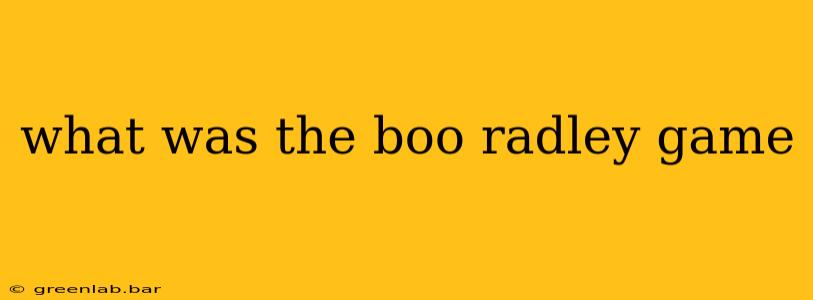Harper Lee's To Kill a Mockingbird isn't just a coming-of-age story; it's a powerful exploration of prejudice, justice, and the complexities of childhood. Central to this exploration is the "Boo Radley game," a chilling yet revealing pastime for Scout, Jem, and Dill. Understanding this game illuminates the novel's deeper themes.
The Game's Mechanics: More Than Just Child's Play
The "Boo Radley game" wasn't a structured game with defined rules, but rather a series of imaginative acts fueled by the children's fascination with and fear of Arthur Radley, the mysterious recluse who lives next door. Their "game" involved enacting various scenarios surrounding Boo, often mimicking his perceived actions and personality based on local rumors and whispers. They would act out what they imagined Boo’s life to be like, often fueled by superstition and the town's prejudice. This included recreating the story of him supposedly attacking his father with scissors, his supposed nocturnal wanderings, and the general mystery surrounding his seclusion.
Key Elements of the "Game":
- Role-Playing: The children assign roles, with Jem often taking the lead as "Boo," acting out his presumed behaviors.
- Imagination and Speculation: The game heavily relies on the children's imagination, filling the gaps of Boo's unseen life with fear-based speculation, which reflects the overall fear and misinformation surrounding him within Maycomb.
- Fear and Excitement: The game is a mixture of childlike playfulness and genuine fear, reflecting the ambiguous nature of Boo himself. The thrill of the unknown, mixed with the potential for danger, makes the game more engaging.
Beyond the Game: Symbolism and Deeper Meanings
The "Boo Radley game" serves as a powerful symbol in the novel, representing several key themes:
1. The Power of Prejudice and Misinformation:
The children's perceptions of Boo are entirely shaped by the prejudiced whispers and rumors circulating in Maycomb. Their game reflects the town's collective fear and misunderstanding of Boo, highlighting how easily misinformation can create monstrous figures from real people.
2. The Exploration of Fear and the Unknown:
The game illustrates the children's natural fascination with the unknown, coupled with their inherent fear of the unfamiliar. Boo Radley, as an unseen and misunderstood figure, becomes a tangible representation of their own anxieties and uncertainties about the world.
3. Childhood Innocence and Growing Awareness:
As the novel progresses, the children's understanding of Boo and the "game" evolves. Their initial playful fear gives way to a more compassionate and nuanced perspective as they gradually learn the truth about him. This evolution mirrors their own journey of growing up and confronting the complexities of their world.
4. The Dangers of Stereotypes and Assumptions:
Through the lens of the "Boo Radley game", Lee reveals the dangerous consequences of relying on stereotypes and assumptions. The children's initial actions based on incomplete and biased information highlight the importance of seeking out facts before making judgments.
Conclusion: A Microcosm of Maycomb
The "Boo Radley game" is more than just childish entertainment in To Kill a Mockingbird. It's a microcosm of Maycomb's society, reflecting the town's prejudice, fear, and ultimately, the limitations of relying on hearsay and speculation rather than understanding and empathy. By exploring the complexities of this seemingly simple game, Lee forces readers to confront their own biases and the dangers of unfounded assumptions. The game acts as a powerful tool to illustrate the central themes of the novel, making it a vital element in understanding its lasting impact.

